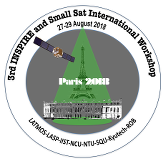Dr
Mustapha Meftah
(LATMOS / CNRS / Paris-Saclay University)
Since April 5, 2008 and up to February 15, 2017, the SOLar SPECtrometer (SOLSPEC) instrument of the SOLAR payload on board the International Space Station (ISS) has performed accurate measurements of solar spectral irradiance (SSI) from the middle ultraviolet to the infrared (165 to 3088 nm). SOLAR-ISS (representative of the 2008 solar minimum) is a solar spectrum based on SOLAR/SOLSPEC data, which has a resolution better than 0.1 nm below 1000 nm and 1 nm in the 1000—3000 nm wavelength range. Now, we are looking to obtain a solar spectrum at higher resolution (less than 0.01 nm) in the 400-5000 nm range. There are four methods to determine the solar spectrum: theoretical, exo-atmospheric, zero airmass extrapolation, and telluric subtraction. Based on the telluric subtraction approach, an empirical solar linelist has been generated by simultaneous fitting of ATMOS, MkIV, Kitt Peak, Denver U, and TCCON spectra (Toon et al., 2014). The telluric absorptions were fitted using the HITRAN linelist and any remaining, airmass-independent absorptions were attributed to the Sun. Together with a simple lineshape function, this linelist allows the computation of a solar pseudo-transmittance spectra for disk-integrated. From this solar pseudo-transmittance spectra (high resolution) and from the SOLAR/SOLSPEC spectrum (absolute determination at lower resolution), we will determine a new reference spectrum at very high resolution (better than 0.01 nm).
Summary
Since April 5, 2008 and up to February 15, 2017, the SOLar SPECtrometer (SOLSPEC) instrument of the SOLAR payload on board the International Space Station (ISS) has performed accurate measurements of solar spectral irradiance (SSI) from the middle ultraviolet to the infrared (165 to 3088 nm). SOLAR-ISS (representative of the 2008 solar minimum) is a solar spectrum based on SOLAR/SOLSPEC data, which has a resolution better than 0.1 nm below 1000 nm and 1 nm in the 1000—3000 nm wavelength range. Now, we are looking to obtain a solar spectrum at higher resolution (less than 0.01 nm) in the 400-5000 nm range. There are four methods to determine the solar spectrum: theoretical, exo-atmospheric, zero airmass extrapolation, and telluric subtraction. Based on the telluric subtraction approach, an empirical solar linelist has been generated by simultaneous fitting of ATMOS, MkIV, Kitt Peak, Denver U, and TCCON spectra (Toon et al., 2014). The telluric absorptions were fitted using the HITRAN linelist and any remaining, airmass-independent absorptions were attributed to the Sun. Together with a simple lineshape function, this linelist allows the computation of a solar pseudo-transmittance spectra for disk-integrated. From this solar pseudo-transmittance spectra (high resolution) and from the SOLAR/SOLSPEC spectrum (absolute determination at lower resolution), we will determine a new reference spectrum at very high resolution (better than 0.01 nm).
There are no materials yet.

